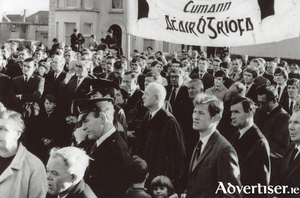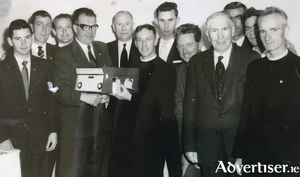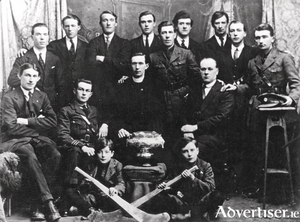Search Results for 'Sen Turke'
3 results found.
The unveiling of a plaque to Fr Griffin

On November 14, 1920, a young curate, Father Michael Griffin, was lured from his house at No 2 Montpellier Terrace by the Black and Tans. Whatever ruse they used to get him out of the house, it was not to go on a sick call, as he did not take the holy oils or the Eucharist with him, but went peacefully. He went missing and volunteers and search parties were organised and combed the city and surrounding countryside looking for him. A week later his body was found buried in a bog at Cloch Sgoilte in Barna. There was an international outcry. He had worked in the parish of Rahoon since June 1918 and was hugely popular. He spoke in Irish to young and old, organised feiseanna, currach races, and donkey races on Silver Strand. He was very republican and was suspected by the Tans of having heard the last confession of the informer Patrick Joyce, which was probably the reason why they abducted him and tried to extract the identity of Joyce's killers from him.
The Street Leagues

In the early 1950’s, a group of people calling themselves Coiste na n-Óg came together to try to improve the standard of Gaelic games in the city and they came up with the idea of a streets league. They divided up the city into sections and their teams were named as follows: St Anthony’s represented Newcastle; Western Stars was the name given to the team drawn from Father Griffin Road, Dominick Street, Henry Street, and ‘The West’; “98s” were from Bohermore/Woodquay, they were named after a famous Bohermore 98s team who were established in 1898, the centenary of 1798; Father Lally’s represented Shantalla, so named after a 19th century progressive charismatic parish priest of Rahoon; St Nicholas’ was the name given to the Claddagh teams; The boys from Salthill were simply known as Salthill. The lads from the Industrial School in Lower Salthill were known as St. Joseph’s they played in the under-14 league as did Club Mhuire and Naomh Pádraic
The Galway City Challenge Hurling Cup 1920

As nationalist sentiment was rising in the early years of the last century, a new generation of GAA officials emerged who were zealous in their belief in the transformative power of the GAA and they saw themselves as engaged in a project of national liberation. Some GAA tournaments were staged as part of a pro-Boer campaign. Police reports noted: “The ambition it seems to get hold of the youth of the country and educate them in rebellious and seditious ideas,” a somewhat hysterical interpretation of the GAA ban on foreign games.

